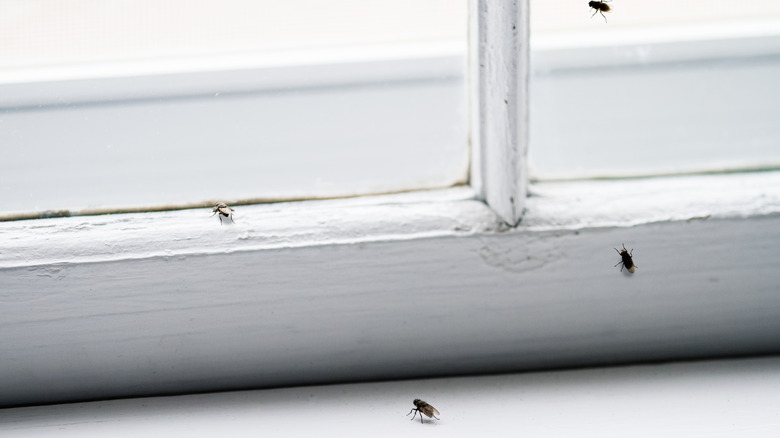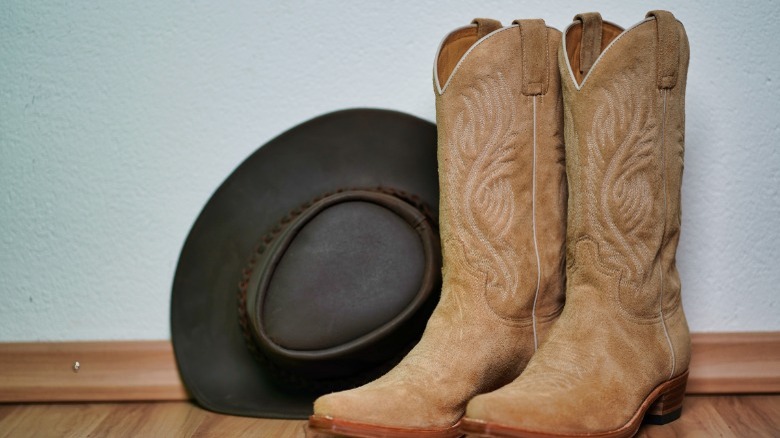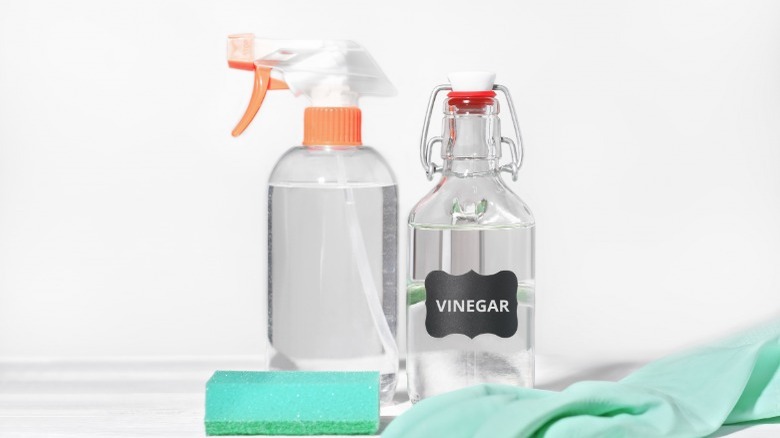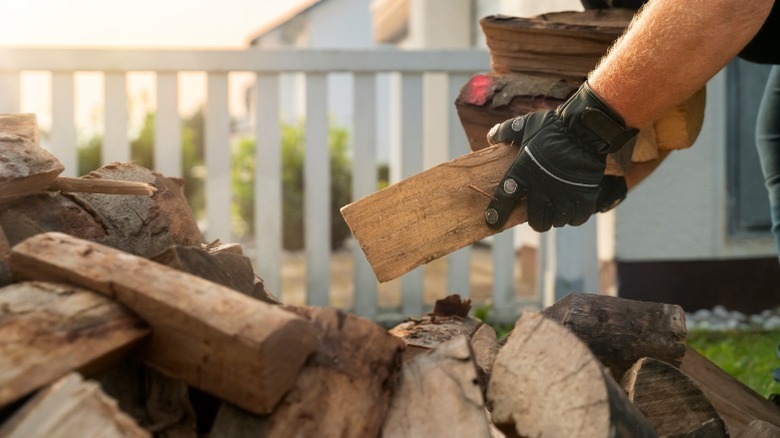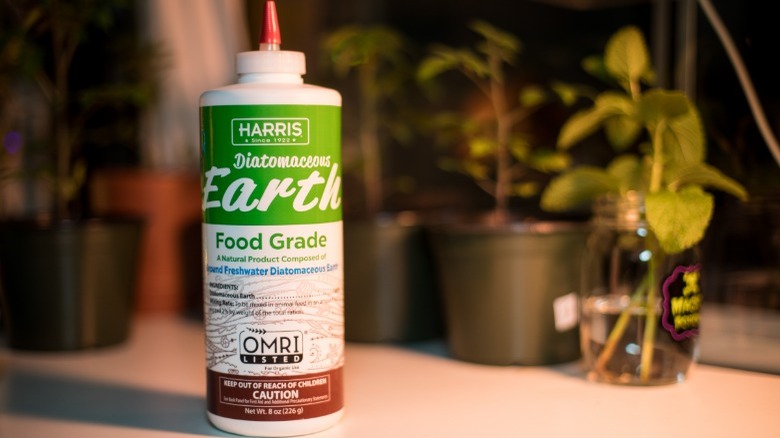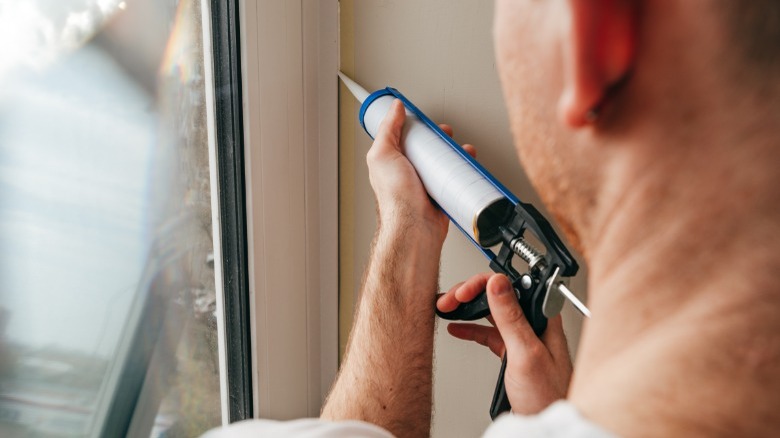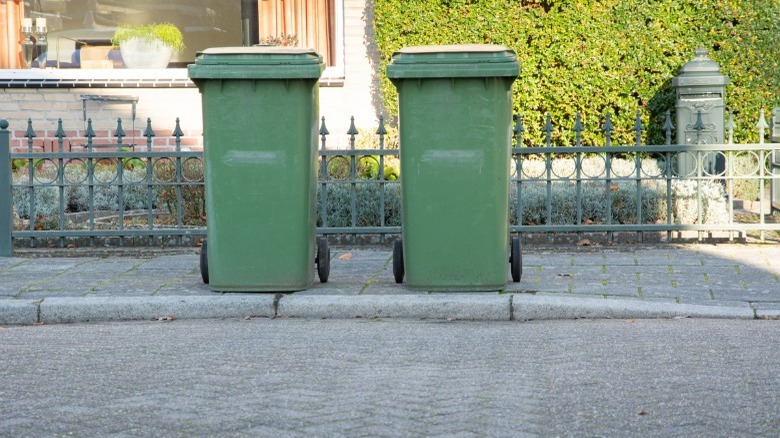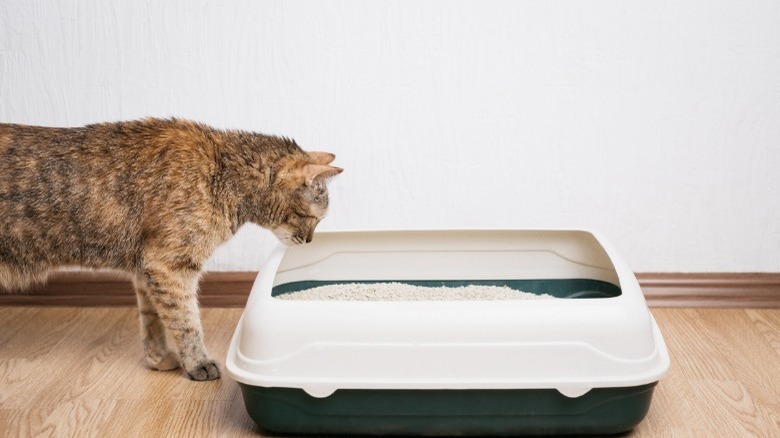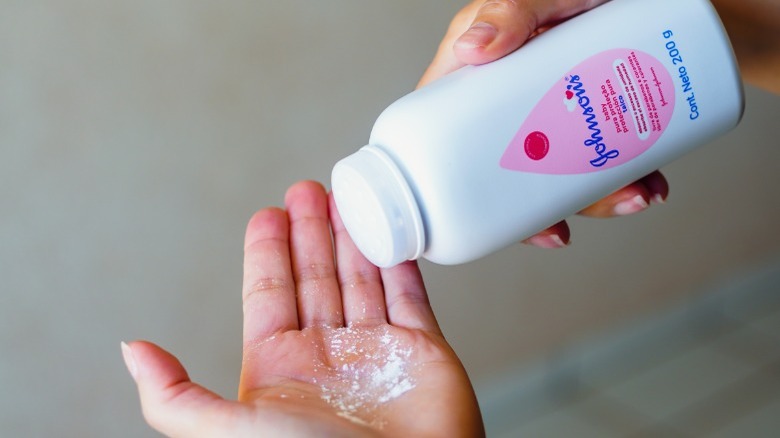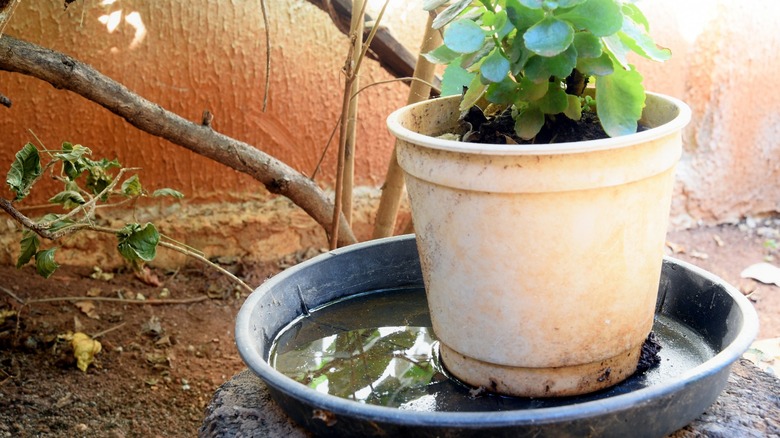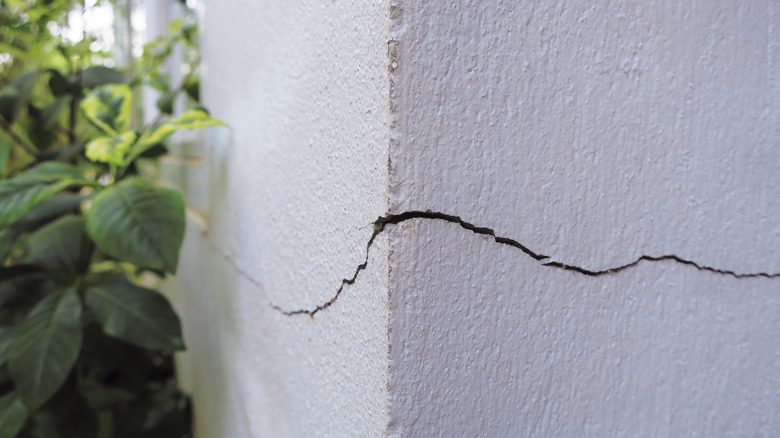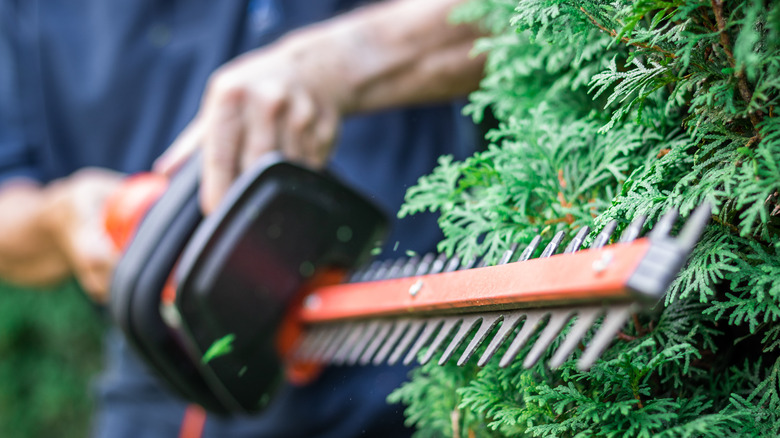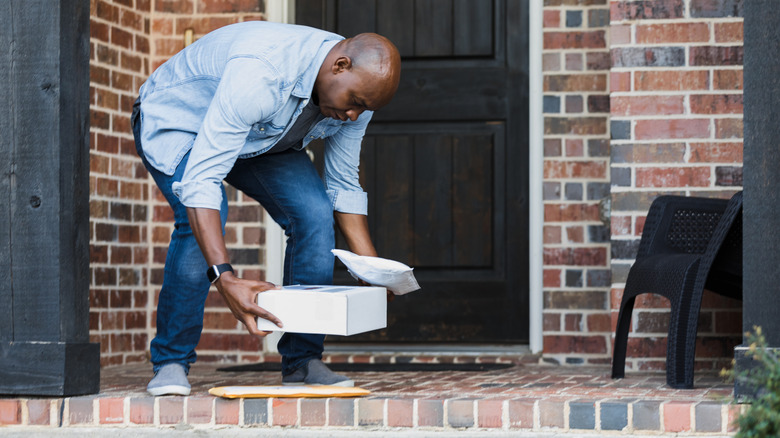17 Hacks That Will Help Keep Insects Out Of Your House
No one likes to deal with bugs in their homes, but sometimes it seems like no matter what you do, they still worm their way in. So, are there any preventative measures you can take to reduce their invasion opportunities that don't involve harsh chemicals? As it turns out, there are. All kinds of organisms we call pests are typically attracted to two things in your house: food and water. Others are looking for shelter, and some just want enough space to post up during cold months. Unfortunately, there's pretty much never a good reason — as far as we're concerned — to invite them in.
Thankfully, during winter we can exhale a little, as overall, insects are at a minimum. However, with spring on the horizon, vigilance reigns supreme. The best thing about these hacks that will help keep insects out of your home is that they're tried and true. Plus, they apply to nearly everyone, and they will help to reduce nearly all pests. If you're intrigued, we invite you to keep reading to learn how to keep your home bug-free.
Reduce foliage and clutter in your yard
One important thing you can do to keep pests out is to reduce their hiding places. Bugs and other pests like to hide under leaves and foliage, as many also eat plants, fruit, nuts, acorns, dead leaves, and practically anything organic you can think of. If you're like many of us, you probably tend to neglect the yard once in a while. However, by not blowing or raking the leaves, and picking up fallen branches, you're providing a haven for all kinds of pests.
Another common shelter is under large rocks and wood, including mulch. Try to keep these bug harbors to a minimum near your home if you want to prevent an over-abundance of pests. In fact, any type of clutter can give critters shelter. Even decorative features like fountains and garden gnomes can be bug havens. So, how do you go about reducing these shelters and attractions so they don't decide to take refuge in your house?
Start by removing debris and cleaning up around any plants, taking old mulch out and preparing to layer with new mulch. Refrain from adding too much mulch, as you don't want to create more moisture than necessary. This is one of the biggest pest attractions, remember? Remove dead plants and flowers and prune dead or damaged branches. If you store firewood, keep it in a shed or somewhere as far from your house as possible — but more on this later. In general, a neat yard with fewer objects right by your home will help to reduce pests.
Keep your shoes off the floor (and always check them)
Pests love dark, damp places to hide. When they get inside your house, that doesn't change! One place they seem to commonly be found in the home is inside of shoes. Scorpions and spiders in particular are drawn to this kind of haven, so the results could be disastrous if you're not careful. Other bugs also could end up in your shoes, however, they don't like to stay in anything that moves and disturbs them when they're not feeding. So, if you're in luck, they may just move on.
Regardless of the critter, no one wants a surprise like that when they go to slip on their shoes, especially if they're not paying attention to what might have taken up residence in them. Reduce pest problems like this by keeping your shoes stored off the ground, and making sure you stay vigilant when you go to put them on. Get or build a shoe rack, or utilize a standard shelving unit. In addition to this, even when they're stored off the ground, always shake them out first before putting on a pair.
Use white vinegar to repel insects
White vinegar is a household ingredient you may not realize is great for deterring pests. Many people prefer not to use pesticides, especially if they have children or pets. Vinegar is especially good at keeping ants and spiders away, and even kills mosquitoes and their larvae. And while insects like fruit flies and aphids are actually attracted to the smell of vinegar, you can make traps for them using a solution made from it that will kill them upon contact.
For general pest prevention using vinegar, dilute by half with water and spray around the perimeter of your home. Spraying both outdoors and indoors is best, paying particular attention to the entryways. Apple cider vinegar can also be used, as well as can be added to any standing water you may have on the property. To make traps, simply mix together the following: 1 quart of water, 12 ounces of vinegar, and 1 tablespoon of dish soap. You can spray bugs directly, or fill a paper cup about a third of the way with the solution and leave in the kitchen, or where ever you have fruit flies. They will go for the liquid, but won't come out.
Store firewood away from your house
As aforementioned, wood is a haven for pests. Additionally, some insects that are attracted to wood are particularly damaging, like termites and carpenter ants. Not only these, but also pests like snakes, spiders, roaches, beetles, and more are known to hide under wood. When firewood is kept in or around the house, you might as well have a neon sign saying "bug me." In general, it's best to not store firewood inside your house, and rather just bring what you need inside as you actually use it.
Taking it one step further, avoid having firewood on the ground, as it will reduce the probability of pests hiding within. You can keep firewood on top of pallets to allow air circulation under it, or something similar that will serve the same purpose. Additionally, cover it with a tarp to keep it protected from the weather. Never use pesticides on your firewood, or you could put your family in danger from breathing the toxic fumes.
Use diatomaceous earth
If you don't like to use chemicals or pesticides, diatomaceous earth is a natural product alternative. According to Insider, this substance is made from ancient fossilized algae called diatoms that are in powder form. It's used for a myriad of things in agriculture and often for pest control. It is unique in the way it works, and is most effective on pests with exoskeletons, which, granted, is a lot of them! The powder works by drying out the moisture in and around bugs and their habitats. It dehydrates and slices up the respiratory system when inhaled by insects, but is harmless to the environment and most other living things.
Since there are different kinds of diatomaceous earth for different purposes, it's important to use the food-grade type for pests in and around the house for ultimate safety. It's also important to use it in the correct way to prevent it from becoming an irritant to everyone else (including pets). The advice is to apply it with a duster can that has a nozzle, rather than sprinkling it all over the house willy-nilly. Stay away from high-traffic areas and instead look for the paths insects travel. And remember to reapply it often, but sparingly. You can also apply it around the base of houseplants.
Keep pet food off the floor and stored properly
If you're an animal lover, you likely have pet food in your house. Unfortunately, this can also be a big attraction for all kinds of pests. Besides the typical ants, roaches, and flies, other insects, like beetles, weevils, and even moths, are commonly found around pet food. Putting food and water bowls out for pets to browse on anytime might seem friendly, but, if you have an insect problem, it may be best to rethink that and instead only feed them at specific times during the day. The point is to not leave food out and to remember to clean up any mess. It makes sense to keep water accessible to your pet, but just keep a close eye on it and change it regularly.
You can also purchase bug-resistant bowls. One particularly effective type is a moated bowl. These dishes have a "moat" around the bowl that you can fill with soapy water. It kills insects before they can get to the food or water, but your pet won't make the same mistake. Other types have special rims that can make it more difficult for bugs to climb over. At night, be sure to remove the food bowls from the floor regardless.
Additionally, keep pet food and supplies stored in sealed containers. You can even put them in the refrigerator for added protection. If you have large bags of pet food to store, put them in sealed plastic containers in the garage or shed, and sprinkle diatomaceous earth around the corners of the area often. If you find a bug infestation in your pet's food, without a doubt, throw it away.
Try peppermint oil
Everyone has probably heard that certain smells repel many insects and other pests, but often their effect is minimal at best. However, there is one essential oil that works well to repel most insects: peppermint. It's also hated by mice, rats, skunks, moles, groundhogs and more. So, as you can see, it makes a great pest prevention measure to take that's not unpleasant to use in and around your home.
The way you use peppermint essential oil to repel pests is by mixing equal parts essential oil and water in a spray bottle. Spray baseboards, entryways, and other problem areas with the solution. You can also take straight peppermint oil and put at least five drops on a cotton ball and place the cotton balls at entry points and throughout the house where you suspect insects are getting in. Replace the peppermint-soaked cotton balls every month with fresh ones. You can even grow your own peppermint indoors as an added measure of prevention and enjoyment.
Seal up all openings using caulk
Another important step in keeping pests out of your home is to do a visual inspection every year and seal up any and all openings where they could get inside. Keep in mind bugs can slip into the tiniest of cracks, so it's important to stay vigilant with this. Probably the easiest and most cost-friendly way to do this is by using caulk. You can find affordable options everywhere, but a good one to use for this purpose is Gorilla Glue Waterproof Clear Caulk & Seal, which you can buy at Walmart for under $10. You'll also need a caulking gun of course.
Check all door and window frames, baseboards, crown molding, vents to the outside, and other spots you suspect. Make sure any weather stripping is intact, and look for any cracks or places where you can see sunlight coming through. Clean the areas you want to reinforce with caulking so that it will adhere with no problems. Then apply the caulk from one corner of the crack to the other in one even line. You can use a putty knife or a spoon to fill in any gaps or to smooth it out. Allow it to dry for at least 24 hours.
Rinse your recyclables
Something you might not think about that's also important for keeping pests out is to rinse all containers you recycle before tossing them in the bin. Insects love the sweet residue inevitably left in these vessels, and are attracted to any location they may be stored. Some common bugs that love these opportunities are ants, cockroaches, flies, fruit flies, etc. And nearly all pests are attracted to water, as well. If you notice a lot of bug activity around your recycling bins, it's probably due to the residue you have left in the containers.
The first thing to do is an unpleasant but necessary task. Clean your recycling bin thoroughly, and repeat this every six to eight weeks, especially if you store the bin in your house. Next, be sure to rinse out all bottles, cans, and jars before tossing them. Additionally, if your recycling center accepts lids and caps, recycle them attached to their original containers, rather than separately. You can also sprinkle some diatomaceous earth around and inside the bins for some extra help.
Keep garbage secure and take it out regularly
Your garbage is a bug's treasure, and securing it is one of the best ways to keep them from accessing it. Since bugs are attracted to almost all food sources in your home or out, removing garbage as soon as it's full is another must. You'll also want to clean the garbage cans at least once a week. For large outdoor bins, just clean them with the hose, sponge, and some dish soap. After rinsing, turn them upside down to dry and keep a portion elevated for air flow. For cleaning inside trash bins, some cleaning spray should do just fine. You can also mist them with peppermint essential oil.
Another tip is to purchase garbage containers with locking lids, or lids that snap into place. This will prevent pests from ever getting into the trash in the first place. The main thing is to ensure your inside garbage is taken out regularly, and that any outdoor bins are kept clean and can be properly closed.
Clean the litter box regularly
Unfortunately, if you have an indoor cat and a litter box, you have a prime candidate for a pest problem. Many pests are attracted to it, such as flies, fruit flies, gnats, bumble bugs, litter beetles (yes, there is such a thing), and so on. And yes, they're attracted to the excrements inside. Aside from the gross factor, it's also unhealthy to not keep the litter box clean. Luckily, there are things you can do to minimize litter box-related insect problems.
For one thing, make sure each cat has its own dedicated litter box, and try using a little less litter at a time to make it easier to clean and keep fresh. Clean the box itself regularly, completely replacing the litter each time. Another thing you can do is buy silica-based litter, which is bad for insects' exoskeletons. The drier the litter stays, the less attractive it becomes. Unfortunately, litters made with organic materials, like grass and corn, are not a good idea because they can be extra inviting to pests.
Keep ants away with baby powder
This hack uses baby powder to get rid of ants in your home! Ants are a problem for many homeowners, and once they start coming in, it's hard to get them out. Ants use pheromone trails to travel the same paths and find the goodies they're after, which is why it can be tough for you to eradicate them once they've started to come inside. Baby powder is an effective tool for eliminating the scent they follow, and by mixing it with chalk, it boosts the effect and provides a necessary barrier as well. There's an easy way to do this.
Once you identify their trails, simply take a piece of chalk and draw lines along them. Then, sprinkle some baby powder over the chalk lines. This will effectively confuse the ants because they can no longer smell the trail. Not only that, but any baby powder the ants bring back to their colony will further throw off their scent-tracking abilities. After you've rid yourself of ants, be sure to go back and seal the former entry points with caulk.
Cinnamon can keep ants out of your house
Small amounts of the common baking spice cinnamon can actually make ants avoid your house. Cinnamon naturally contains cinnamaldehyde, which is the chemical that gives the spice its signature sweet taste and pleasant smell. While enticing to humans, both of these are deadly to ants. Researchers discovered that when ants ingest cinnamaldehyde, it essentially causes their nervous systems to short-circuit, leading to their eventual death. In addition, the strong smell of the chemical can overwhelm and confuse the ants, making it difficult for them to find their way. Since rely on pheromone trails and "follow the leader," disrupting this parade can end your infestation.
You can use powdered cinnamon to accomplish the task or mix cinnamon essential oils with water to create a DIY ant spray. You can apply both directly to the ants if you see them, but you should also take the time to investigate where they are entering your home. You can then spray your mixture over the area, or leave a barrier of powdered cinnamon. While you might not be able to rely on cinnamon to completely rid your house of ants, it's a great start for a natural way to keep your home pest-free.
Eliminate standing water and excess moisture
Taking steps to eliminate standing water and any other issues that are increasing moisture in your home is key if you want to keep bugs out. Several pests are attracted to moisture, including roaches, mosquitoes, termites, and silverfish. Termites feast and reproduce around damp wood, cockroaches and silverfish thrive in areas with higher humidity, and mosquitoes lay their eggs in standing water. So, if you would like to keep all of these crawling and flying pests — along with several others — away from your home, get rid of the source that facilitates their survival.
Start by eliminating standing water. If you have any tubs or buckets holding water inside or outside of your house, dump them out. Inspect your yard for anything that catches and holds rainwater to prevent the bugs from congregating around the outside of the home before making their way inside. It is also important to promptly address any leaks. It just takes a few drips from a leaky faucet or toilet to provide a water source for these creatures. If any areas of your home are often humid, setting up a dehumidifier would also be a good idea.
Seal cracks in the foundation and siding
Insects are, obviously, much smaller than us. They don't need a wide open door or even an open window to allow them to gain access to your home. All it takes is a small opening or crack, and they're in. We already discussed the importance of sealing any cracks around your windows, vents, and baseboards, but don't forget to perform a detailed inspection of your home's siding and foundation. As you go around the house, pay close attention to the areas where utility lines and pipes enter your home; you may notice some cracks around them as well.
If you do find any holes or crevices where the pests can sneak in, act quickly to seal them. While expanding caulk may seem like the ideal solution for this task, it is actually not the best choice. Some pests will be able to gnaw their way through it and let themselves in. Instead, use mortar, copper mesh, sheet metal, or another more impenetrable material, depending on the type of patch you need to make. If necessary, hire a qualified professional to tackle more involved repairs.
Trim back trees and bushes so they don't touch entry points
Do bushes line your front windows? Do you have tree branches growing out right up against the side of your house? If so, you may have just identified how the pesky bugs have been letting themselves into your home. When branches or leaves are right up against the side of a house, they can act like a bridge, making it easier for insects to access any cracks in the siding or along your windows or doors.
Fortunately, all you'll need to do to limit access is to trim these landscaping elements back so they're not right up against the house. Use either a manual or power trimmer to cut the bushes back so that they are a minimum of 6 inches away from the side of your home. However, a greater distance of 3 feet may be even more effective. You may need to hire a professional tree trimming company if higher branches are encroaching on your roof or siding. By cutting your trees and bushes back, you'll also be protecting your siding, windows, and roof from damage that could be caused during a storm.
Inspect everything before bringing it into your home
Sometimes, bugs don't come into your house on their own. Believe it or not, you may actually be bringing them in. They can hitch a ride on packages, the bottoms of your shoes, plants, and nearly anything else that you carry in with you. To avoid inadvertently being responsible for an infestation in your home, inspect everything that you bring inside with you.
One thing you can do is to look for evidence of any insects. This may include bite marks, droppings, or shed exoskeletons. If you see any of these signs, stop and evaluate the best course of action. This will depend on the type of item you're bringing in. For example, you may choose to leave the plant you wanted to move inside outside or may decide that it is best to wash down the patio furniture before storing it in the basement. Opening packages outside is another trick you can try. This will allow you to spot any critters before they actually get into your house. If you do find any creepy crawling creatures, dispose of the box in a sealed bag or bin outside of your home.
